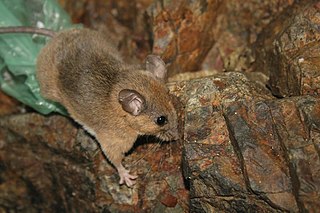Schmidly's deer mouse, is a recently described species of deer mouse from the mountains of western Mexico. It is part of the highly complex and well-studied Peromyscus boylii species complex. The uniqueness of Peromyscus from this area had long been suspected, but was only formalized in 2004 with the publication of its species description. The species was named in honor of David J. Schmidly, a mammalogist and former president of the University of New Mexico.

The Mexican volcano mouse is a species of rodent in the family Cricetidae endemic to high elevation areas of the Trans-Mexican Volcanic Belt.

The Perote mouse, or Perote deer mouse, is a species of rodent in the family Cricetidae. It is found only in Mexico.
Burt's deer mouse is a species of rodent in the family Cricetidae. It is endemic to Mexico, where it is found only on Montserrat Island off the east coast of Baja California Sur. The species is threatened by predation by feral cats.
Dickey's deer mouse is a species of rodent in the family Cricetidae. It is endemic to Mexico, being found only on a small island in the Gulf of California. The species is named for Donald Dickey, who sponsored the expedition that first discovered the animal.
Eva's desert mouse is a species of rodent in the genus Peromyscus of the family Cricetidae found only in the Baja California peninsula of Mexico.
The Angel Island mouse, or La Guarda deermouse, is a species of rodent in the family Cricetidae.
Hooper's mouse is a species of rodent in the family Cricetidae. It is the only member of the Peromyscus hooperi species group, and is found only in Mexico. The species is named for Emmett Hooper, a researcher into the taxonomy of the genus Peromyscus.
The nimble-footed mouse is a species of rodent in the family Cricetidae. It is found only in Mexico.

The Tres Marías island mouse or Tres Marías deer mouse is a species of rodent in the family Cricetidae. It is found only on the Islas Marías off the west coast of Mexico. When last assessed, it was common on María Cleofás Island, but rare or absent on the other, more disturbed, islands.
The Puebla deer mouse is a species of rodent in the family Cricetidae. Only two specimens are known, both from Puebla, Mexico, with the last collected in 1947. It is therefore possible that the species is now extinct, although it is currently listed as Critically Endangered by the IUCN.

The black-eared mouse, or black-eared deer mouse, is a species of rodent in the family Cricetidae, native to North America.
The black-tailed mouse is a species of rodent in the family Cricetidae endemic to Mexico.

The Mexican deer mouse is a species of forest-dwelling rodent in the family Cricetidae. It is found in southern Mexico and throughout much of Central America.
The tawny deer mouse or marsh mouse is a species of rodent in the family Cricetidae. It is found only in Mexico.
The false canyon mouse or Coronados deer mouse, is a species of rodent in the family Cricetidae. It is known only from Coronados Island, a small island in the Gulf of California, part of Baja California Sur, Mexico. The species is threatened by predation by feral cats, and the IUCN has assessed its conservation status as "critically endangered".
The Santa Cruz mouse is a species of rodent in the family Cricetidae. It is endemic to Mexico, where it is found only on two small islands in the southern Gulf of California. Feral cats on Santa Cruz Island are a threat.

The Nayarit mouse or Sinaloan deer mouse is a species of cricetid rodent endemic to Mexico. It was considered a subspecies of brush mouse until 1977.

Slevin's mouse, also known as the Catalina deer mouse, is a species of rodent in the family Cricetidae. It is endemic to Isla Santa Catalina off the east coast of Baja California Sur, an island with an area of about 40 km2 (15 sq mi), and it is the only native mammal on the island. It is named for Joseph Slevin, a curator at the California Academy of Sciences.
The narrow-skulled pocket mouse is a species of rodent in the family Heteromyidae. It is endemic to western Mexico, living west of the Sierra Madre Occidental crest.







